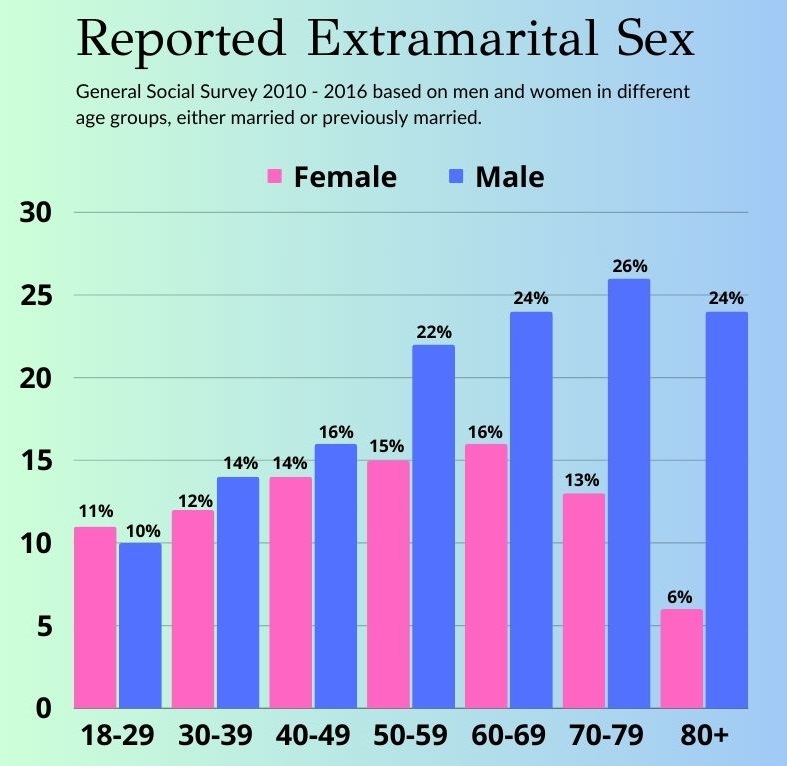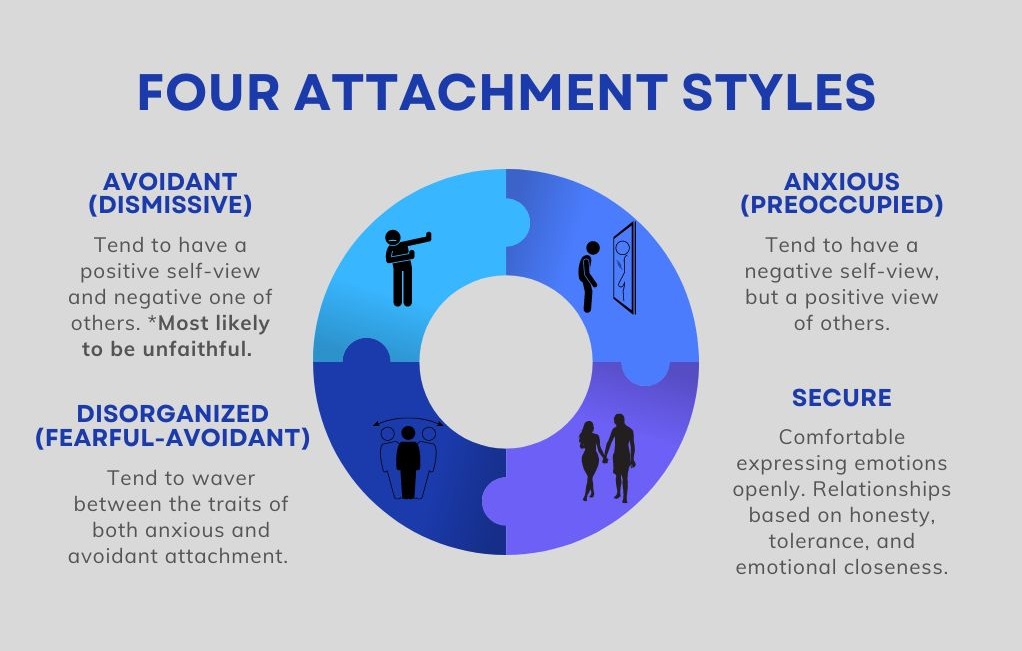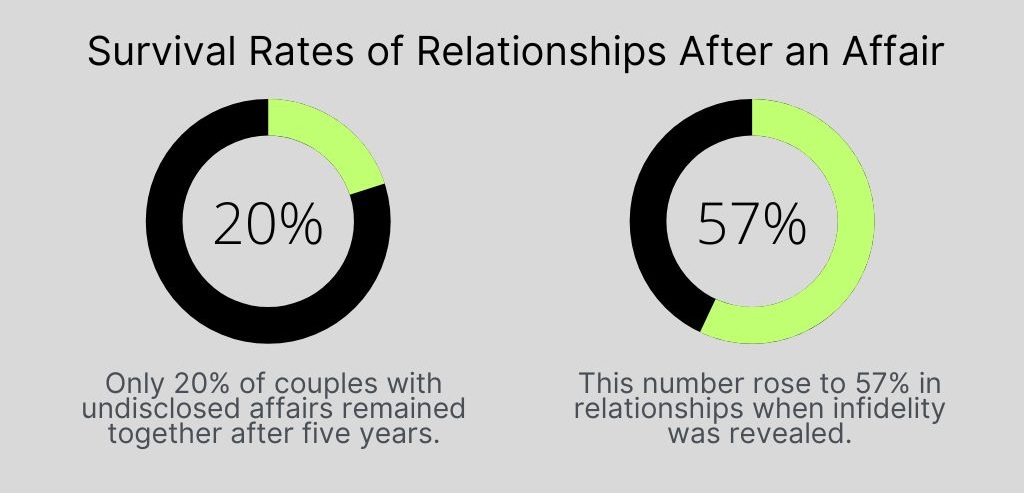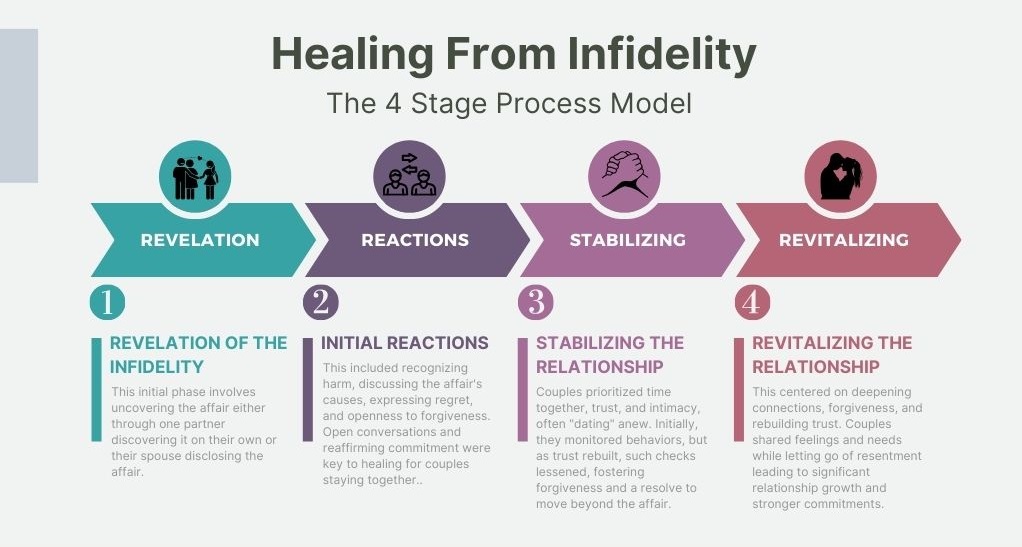
Who Cheats More Men or Women? | 2024 Infidelity Statistics
The age old question of who cheats more men or women has sparked endless debates and countless studies. You might have come here out of curiosity, concern, or in search of clarity after uncovering an affair. Infidelity, often veiled in secrecy and considered a taboo subject, affects more relationships than many of us are willing to admit.
Throughout this article, we’ll delve into the depths of research, studies, and statistics to gauge the prevalence of infidelity in relationships and unpack its underlying reasons and motivations. Moreover, we’ll explore strategies for salvaging and strengthening a relationship post-affair.
Whether you’re personally dealing with these issues or just aiming to understand this complex facet of human relationships better, this piece provides an in-depth exploration of the many layers of infidelity.
- Who Cheats More Men or Women? | 2024 Infidelity Statistics
- How Common is Infidelity in Relationships? & Who Cheats More Men or Women?
- Why Do People Cheat on Their Spouses?
- Enduring, Healing, and Thriving in Relationships After Infidelity
- From the Ashes of an Affair to a Thriving Relationship
- Sources
- About the Author
How Common is Infidelity in Relationships? & Who Cheats More Men or Women?

Infidelity in relationships is more common than you might think, and the statistics paint a vivid picture. Let’s dive into the results of some key studies and articles we have come across to understand the reality of cheating in relationships.
Estimates suggest that infidelity occurs in about 25% of all marriages over the course of a lifetime9.

Percentage of Cheating Men and Women
One study found that 20% of men and 13% of married women admitted to having sex with someone outside their marriage, averaging 16% overall1.
A more recent study suggests that the prevalence of infidelity is underreported due to the way individuals are questioned about their behaviors. Direct questioning revealed that 9% of women and 17% of men acknowledged being unfaithful2. However, when participants were provided with a checklist to identify specific sexual behaviors outside their primary relationship, the numbers surged dramatically. The results gathered from the checklist found that 15% of women and 27% of men had engaged in intercourse with someone other than their partner, averaging 21% overall2.
Statistics for Who Cheats More Men or Women
The Institute for Family Studies published results of a General Social Survey from 2010 to 2016 based on men and women in different age groups, either married or previously married, reporting extramarital sex1. The survey findings revealed an increasing disparity between men and women in terms of who admitted to cheating more, varying across different age groups:
- Men were more likely to be unfaithful at all age groups except a notable exception between the ages of 18 and 291.
- Women were most likely to cheat on their spouses between the ages of 60 and 69, with a 16% likelihood1.
- In comparison, men were most likely to cheat on their spouses between the ages of 70 and 79, with a 26% likelihood1.

53.4% of affairs happen with someone the individual knows very well. This could be a friend, a coworker, or even a neighbor3. Specifically, 44% of cheating men had an affair with someone from work, making the workplace a common ground for infidelity3. On the other hand, 53% of cheating women had an affair with a friend, showing that emotional connections often pave the way for infidelity among women3.
The choice of affair partner also varies significantly between genders. While 27% of cheating men had an affair with a stranger, only 9% of women did the same4. This further suggests that men might be more inclined towards physical or casual encounters. In contrast, women may seek a more emotional connection.
Since 1990, the number of women who admit to cheating has risen by 40% while men’s statistics have remained about the same5. This trend in recent decades suggests a shift in societal norms and attitudes toward female sexuality and autonomy. It aligns with broader societal changes, including shifts in gender roles, the increased participation of women in the workforce, and the evolving dynamics of marriage and relationships. So, the response to do men or women cheat more may not consistently favor men in the future.
In the last twenty years, the internet has provided increased opportunities for infidelity. Up to 30% of internet users go online for sexual purposes, and up to two-thirds of them engage in offline sexual intercourse with their online partner10.
Why Do People Cheat on Their Spouses?

The reasons why people cheat are complicated and often involve a range of underlying motivations. The following insights from pivotal research and scholarly works delve into the myriad factors contributing to infidelity, helping to explain why this continues to be so common.
According to the Deficit Model of Infidelity, unfaithfulness is often the result of unmet needs or deficiencies within a relationship7. These unmet needs can be emotional, such as a lack of affection, understanding, or support, or they can be physical, such as dissatisfaction with the sexual relationship. This model emphasizes the importance of communication, emotional intimacy, and sexual satisfaction in maintaining a faithful and fulfilling relationship.
Men with pregnant wives were found to cheat more, particularly if they were unhappy in their marriage13. They might feel emotionally distanced because of the attention on the pregnancy or experience less intimacy due to pregnancy-related changes, leading them to seek an emotional or physical connection elsewhere. The anticipation of becoming a father and the associated responsibilities might be overwhelming for some men, and the added pressures and changes might exacerbate existing issues, making infidelity seem like an escape or solution to their unhappiness.
Surprisingly, 56% of cheating men and 34% of cheating women consider their marriages happy, complicating the narrative that only unhappy people cheat6. While dissatisfaction is a common catalyst, even those in “Happy” relationships can cross the line.
In a meta-analysis of 12 infidelity studies among married couples, 31% of men and 16% of women had had a sexual affair that entailed no emotional involvement; 13% of men and 21% of women had been romantically but not sexually involved with someone other than their spouse; and 20% of men and women had engaged in an affair that included both a sexual and emotional connection7. These findings suggest that women are more likely to seek emotional and intimate connections outside their marriage rather than purely physical or sexual fulfillment. This contrasts with men, who are more inclined to pursue affairs for sexual experiences.
Neuroticism was associated with a significantly higher likelihood of infidelity13. It may be that impulsivity is the aspect of neuroticism that gives rise to this notable increase.
Relationship-related personality traits can also play a key role. Knowing which attachment style you and your partner have (Secure, ambivalent, avoidant, or disorganized) can help you better recognize the challenges you might face in your romantic relationship.

People who prefer to keep their distance in relationships, known as having an avoidant attachment style, are more likely to be interested in other romantic options and to cheat. This was confirmed across eight different studies12. Their lack of commitment to their partner makes them more open to alternatives and infidelity. Those who don’t feel close to their partners are less likely to resist short-term temptations that could have long-term adverse effects.
On the other hand, people with an anxious attachment style who seek closeness do not show this tendency, as cheating could jeopardize their desired closeness. The findings conclude that feeling committed to a partner strongly discourages actions that could harm the relationship12.
Marianne Brandon’s insights in her Psychology Today article suggest that losing sexual interest over time is a common and natural challenge, not a personal failure. In her view, humans did not evolve to feel intense passion for the same person over many years, leading to a common issue where around 20% of marriages lack sexual activity15. Often, at least one partner deeply misses the intimate connection.
The book “Sex at Dawn” argues that issues like infidelity and sexual dissatisfaction in modern relationships arise from a clash between society’s expectations for monogamy and humans’ natural inclination towards polyamory, a trait from before agriculture developed around 10,000 BCE16. Despite its controversial stance, the book has sparked debates about the nature of human sexuality, the flexibility of sexual relationships, and the potential for understanding and improving modern relationships by re-examining the past.
In her TED Talk “Rethinking Infidelity,” Esther Perel delves into the complexities of why people cheat and the impact of affairs on relationships. Perel suggests that affairs often reflect a search for lost parts of oneself or an escape from feelings of stagnation, rather than a simple lapse in monogamy. She proposes that at the heart of most affairs is a quest for desire, not just sex, and advises couples to consider the possibility of rebuilding their relationship anew post-affair.
The causes of infidelity are varied and complex, ranging from emotional and physical dissatisfaction to our evolutionary history. Cheating isn’t just found in unhappy relationships; for some, it might be more about unmet needs and desires. Esther Perel offers a hopeful view, suggesting that infidelity can lead a couple to a fresh start in a new relationship with the same partner.
Enduring, Healing, and Thriving in Relationships After Infidelity

As a private investigator, I’ve witnessed the turmoil infidelity brings into relationships. Yet, the journey doesn’t end with the discovery of an affair. The question that looms large is: Can couples not only stay together after infidelity but build a stronger connection?
Percentage of Relationships that Work After Cheating
One study showed a stark difference in the survival of relationships based on how infidelity comes to light. Only about 20% of couples with undisclosed affairs remained together after five years17. This number rose to 57% in relationships when infidelity was revealed17.

Facing the fallout from infidelity is a harrowing experience for all parties involved. The betrayed partner grapples with hurt and a sense of betrayal, while the one who cheated might struggle with guilt and shame. It’s a period marked by intense emotional turmoil.
Yet, many couples choose to stay together. The path to reconciliation is paved with hope, a willingness to change, and seeing the affair as a painful but potential opportunity for growth.
A study from Texas Tech University recently explored how couples can recover and even flourish after experiencing infidelity18. The research focused on 16 couples who had gone through sexual infidelity, decided to stay together, and reported significant healing.
The researchers organized their findings into a four-stage healing model:

- Revelation of the Infidelity: The initial phase for the couples in this study involved uncovering or revealing the affair, setting the stage for the ensuing emotional distress and the potential for healing and reconciliation.
- Initial Reactions: In the second phase, the unfaithful partner acknowledged the harm they inflicted. Open and honest dialogue played a vital role. Many non-straying partners found it essential to be fully aware of the specifics of the affair and the underlying reasons. The unfaithful partner often expressed regret, whereas the faithful partner was willing to explore forgiveness. At this delicate stage, couples emphasized reaffirming their commitment and dedicating themselves to repairing their bond.
- Stabilizing the Relationship: In the third phase, the couples focused on spending more time together, rebuilding trust and intimacy. They tried to reconnect with some “dating” again, like in the early stages of their relationship. Initially, many used measures like checking phones or sharing locations to verify the unfaithful partner’s behavior change. Over time, as trust grew, such checks diminished, leading to forgiveness and a commitment to move past the affair and forward in the relationship.
- Revitalizing the Relationship: The final phase focused on the couples strengthening their emotional bonds, forgiving, and building trust. The couples discussed their feelings about the infidelity and their needs. Forgiveness, seen as offering a second chance, was crucial for healing, allowing the non-straying partners to release resentment. Self-forgiveness for the straying partners followed their partners’ healing. Rebuilding trust was challenging, with ongoing efforts to restore it over time, including the need for reassurance. Growth post-infidelity was significant, with many of the couples recognizing their strengthened bond and commitment. For some, therapy contributed to this growth by improving their communication and understanding.
According to this model, healing from the affair involved a series of steps where the couples worked together to rebuild their bond. This process included:
- Assessing the Damage
- Affirming Commitment
- Establishing Accountability
- Seeking Reconnection
- Communicating Deeply
- Re-establishing Trust
- Moving from Initial to Deeper Level of Forgiveness
Healing from infidelity isn’t easy, and it doesn’t happen overnight. But with commitment, open communication, and a willingness to forgive, many couples find their relationships can emerge stronger and more resilient.
From the Ashes of an Affair to a Thriving Relationship
Understanding the prevalence of infidelity and the various forms it can take is the first step in confronting this challenging aspect of relationships.
Recognizing the factors contributing to infidelity, from unmet needs within a relationship to the influence of societal changes, helps understand the “Why” behind the actions.
The aftermath of an affair is complex, filled with intense emotions and tough decisions. However, as we’ve seen, it’s not necessarily the end of the road for a relationship. With honesty, commitment to healing, and a willingness to address the underlying issues, many couples find a way to move past the betrayal and rebuild a stronger, more resilient bond.
Our Signs of an Unfaithful Partner Red Flags to Watch For article identifies the behavior patterns associated with infidelity and our Complete Guide on How to Catch a Spouse Cheating serves as an overview for these cases, including the methods of investigating an unfaithful partner and post-investigation considerations.
For a complimentary, obligation-free consultation, please get in touch with us at 604-657-4499, info@shadowinvestigationsltd.ca, or fill out our contact form with your preferred contact method and a brief overview of what you would like assistance with. We keep all information confidential and only use contact information to respond to inquiries.
Sources
- Wang, W. (2018). Who cheats more? The demographics of infidelity in America. https://ifstudies.org/blog/who-cheats-more-the-demographics-of-cheating-in-america
- Yabin Tang, Jason D. Hans & Laura M. Vowels (2023) Comparison of Indirect and Direct Approaches to Identifying an Unfaithful Partner, Journal of Sex & Marital Therapy, 49:3, 287-298, DOI: 10.1080/0092623X.2022.2102098
- McPherson, D. (2018). Extramarital sex partners likely to be close friends, and men are more apt to cheat. https://www.colorado.edu/asmagazine/2018/04/04/extramarital-sex-partners-likely-be-close-friends-and-men-are-more-apt-cheat
- Zietsch, B.P., et al. (2014). Genetic analysis of human extrapair mating: heritability, between-sex correlation, and receptor genes for vasopressin and oxytocin. https://www2.psy.uq.edu.au/~uqbziets/Zietsch%20et%20al%202014%20Genetic%20analysis%20of%20extrapair%20mating.pdf
- Perel, E. (2018). The State of Affairs: Rethinking Infidelity. HarperCollins. https://www.amazon.ca/State-Affairs-Rethinking-Infidelity/dp/0062322591
- Glass, S. P., & Wright, T. L. (1985). Sex differences in type of extramarital involvement and marital dissatisfaction. Sex Roles: A Journal of Research, 12(9-10), 1101–1120. https://doi.org/10.1007/BF00288108
- Tsapelas, I., et al. (2010). Infidelity: when, where, why. http://www.helenfisher.com/downloads/articles/INFIDELITY.pdf
- Psychology Today. (n.d.) Infidelity. https://www.psychologytoday.com/us/basics/infidelity
- Rokach A, Chan SH. Love and Infidelity: Causes and Consequences. Int J Environ Res Public Health. 2023 Feb 22;20(5):3904. doi: 10.3390/ijerph20053904. PMID: 36900915; PMCID: PMC10002055.
- Hertlein KM, Webster M. Technology, relationships, and problems: a research synthesis. J Marital Fam Ther. 2008 Oct;34(4):445-60. doi: 10.1111/j.1752-0606.2008.00087.x. PMID: 19017184.
- Atkins, D. C., Baucom, D. H., & Jacobson, N. S. (2001). Understanding infidelity: Correlates in a national random sample. Journal of Family Psychology, 15(4), 735–749. https://doi.org/10.1037/0893-3200.15.4.735
- DeWall, C. N., Lambert, N. M., Slotter, E. B., Pond, R. S., Jr., Deckman, T., Finkel, E. J., Luchies, L. B., & Fincham, F. D. (2011). So far away from one’s partner, yet so close to romantic alternatives: Avoidant attachment, interest in alternatives, and infidelity. Journal of Personality and Social Psychology, 101(6), 1302–1316. https://doi.org/10.1037/a0025497
- Whisman MA, Gordon KC, Chatav Y. Predicting sexual infidelity in a population-based sample of married individuals. J Fam Psychol. 2007 Jun;21(2):320-4. doi: 10.1037/0893-3200.21.2.320. PMID: 17605555.
- Treas, J., & Giesen, D. (2000). Sexual Infidelity among Married and Cohabiting Americans. Journal of Marriage and Family, 62(1), 48–60. http://www.jstor.org/stable/1566686
- Marianne Brandon Ph.D. (2021) Psychology Today. (n.d.) Infidelity. https://www.psychologytoday.com/us/basics/infidelity
- Ryan et. al., (2010) Sex at Dawn: The Prehistoric Origins of Modern Sexuality. HarperCollins. https://www.amazon.ca/Sex-Dawn-Stray-Modern-Relationships-ebook/dp/B007679QTG
- Marín, R. A., Christensen, A., & Atkins, D. C. (2014). Infidelity and behavioral couple therapy: Relationship outcomes over 5 years following therapy. Couple and Family Psychology: Research and Practice, 3(1), 1–12. https://doi.org/10.1037/cfp0000012
- Fife, S. T., Gossner, J. D., Theobald, A., Allen, E., Rivero, A., & Koehl, H. (2023). Couple healing from infidelity: A grounded theory study. Journal of Social and Personal Relationships, 40(12), 3882-3905. https://doi.org/10.1177/02654075231177874
About the Author

